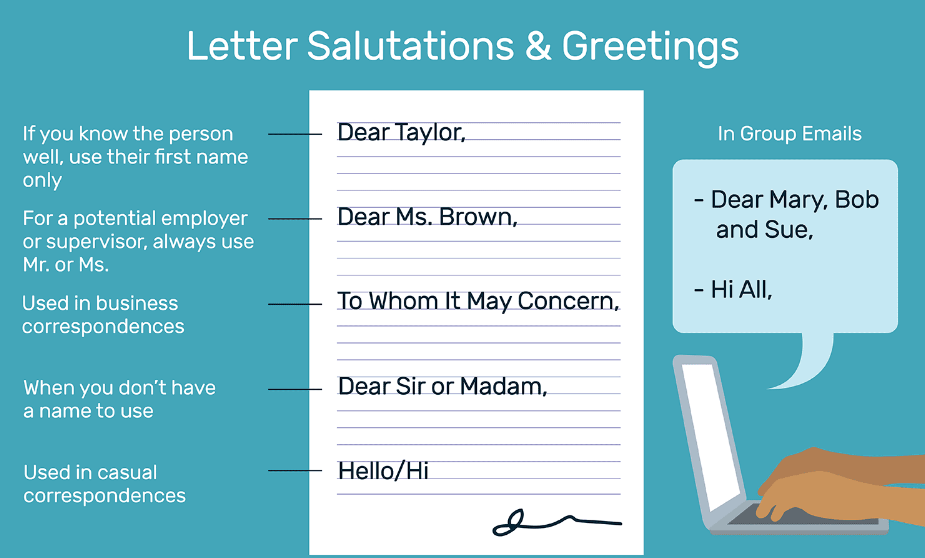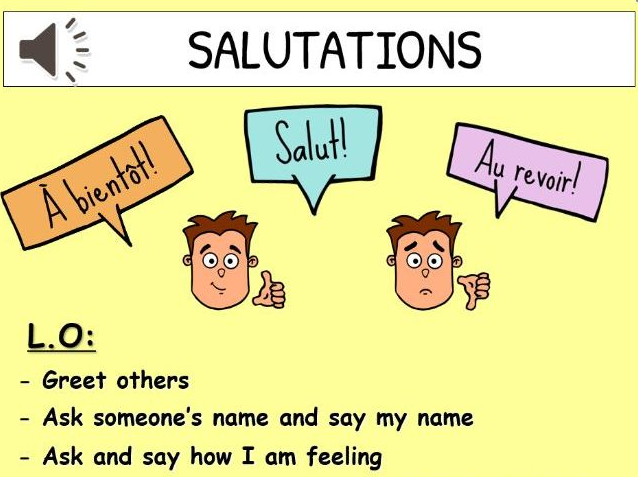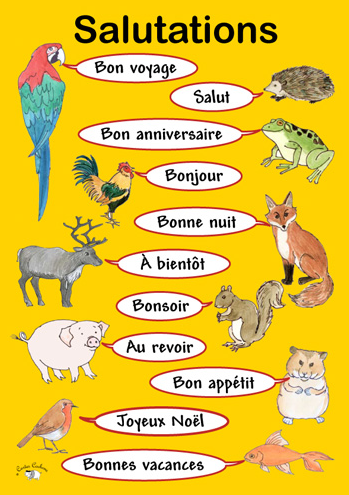Table of Contents
A salutation is a greeting that you use at the beginning of a letter or an email, to address the person you’re writing to and to set the tone of the message. In letters, most salutations begin with the word “Dear.” Sometimes people who aren’t used to English letter-writing conventions feel that this is far too friendly a beginning! But don’t worry; English-speaking readers won’t think you’re being affectionate if you call them “Dear.” This is the standard way to begin a salutation in English, even informal letters. If you’re writing to someone that you’re on a first-name basis with, you can use the person’s first name in the salutation: Dear Laura, Dear Matt.
But if you don’t know the reader well, use the person’s professional title or preferred courtesy title with the last name: Dear Professor Brown, Dear Dr. Grant, Dear Ms. Smith, Dear Mr. Jones, Dear Mx. White. (Note that “Mx.” is a gender-neutral courtesy title that may be used by people who either don’t identify with one of the binary genders or prefer not to be identified by gender.) If you’re writing to someone whose name you don’t know or to a group, a good option is a generic salutation such as “Dear Customer Service Manager” or “Dear Colleagues.” “Hello” and “Hi” are also common salutations. They’re more likely to be used in less formal correspondence, such as emails.
Salutations
Crafting a professional email salutation is all about tone. By creating an appropriate tone at the beginning of your email, you set the tone for the rest of the included subject matter. Although some employers may give you free rein to compose an email salutation how you see fit, a professional option gives you an enhanced image in the eyes of the recipient. To construct an email salutation, consider your relationship with the recipient. If you’ve never met them before, the more formal you are, the better. Other companies that you’re a liaison to for your own employer might give you a bit more leeway, especially if an informal or friendlier tone has already been the norm.

Sometimes, you might have limited information about who you’re addressing. This is often the case with cover letters or emails to certain departments who don’t have a specific contact person. In this instance, it’s best to leave your email salutations short and to the point. Putting “Hello” instead of “Dear Hiring Manager” is often the preference. However, you’ll have to analyze the situation on your own to decide the best course of action.
Valediction
A valediction, or complimentary close in American English, is an expression used to say farewell, especially a word or phrase used to end a letter or message, or the act of saying parting words- whether brief or extensive. For the greetings counterpart to valediction, see salutation. Alternatively, valediction can refer to the final prayers and remarks at the graveside before burial given by the presiding priest, after the Mass and the rite of Final Commendation, during a Roman Catholic Funeral Service.

Salutation Definition
Before you get into the dozens of possible email salutations, ask yourself these questions to point you in the right direction:
- What is the nature of my relationship to the recipient? This is perhaps the most important question to ask. If you’ve never met the recipient, you should always use formal email salutations. If you have a friendly, personal relationship with the recipient, you can afford to use a more casual greeting.
- What is the recipient’s perspective or context? If the recipient has no idea who you are or you’re trying to set a tone of professionalism, consider how the recipient would respond to your email. This goes hand-in-hand with taking the time to find the recipient’s name and any other pertinent information. Think about how you would react to certain email greetings from various people and set your salutation accordingly.
- What is the goal or subject matter of the email? Because the email salutation sets the tone for the email, consider what you’re writing about when you write your salutation. If you’re writing a note to let a colleague or management know that the company lost an account, use a formal greeting. If you’re sending a note about the birth of a child to your boss, you can use something more informal.

What Is An Example Of A Salutation?
The Definition Of A Salutation In A Greeting. An Example Of A Salutation Is When You Write “Dear Dean..” At The Top Of A Letter. An Example Of A Salutation Is When You Say A Formal Hello To Someone.
What Is A Closing Salutation?
Sincerely, Regards, Yours Truly, And Yours Sincerely – These Are The Simplest And Most Useful Letter Closings To Use In A Formal Business Setting. These Are Appropriate In Almost All Instances And Are Excellent Ways To Close A Cover Letter Or An Inquiry.
What Is Meant By Salutation In The Letter?
A Salutation Is A Greeting, Whether It’s “Dear Sir” In A Letter Or “Hey There!” In-Person. The Expression “Greetings And Salutations!” Contains Two Words Meaning Pretty Much The Same Thing: A Salutation Is A Form Of Greeting. In A Letter, The Salutation Is The Part That Says “To Whom It May Concern” Or “Dear John.”
Which Salutation Should I Use?
The Salutation Should Typically Use The Person’s Last Name, Along With A “Mr.” Or “Ms.” In General, Avoid Using “Mrs.” Or “Miss” Unless You Are Certain Of How A Female Recipient Wants To Be Addressed. When In Doubt, Default To Using “Ms.”
What Is A Proper Salutation?
A Salutation Is A Greeting Used In A Letter Or Other Written Or Non-written Communication. Salutations Can Be Formal Or Informal. The Most Common Form Of Salutation In An English Letter Is Dear Followed By The Recipient’s Given Name Or Title. Some Greetings Are Considered Vulgar, Others “Rude” And Others “Polite”.
